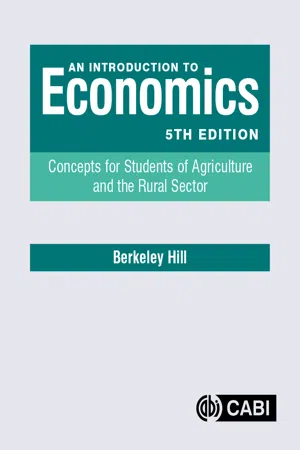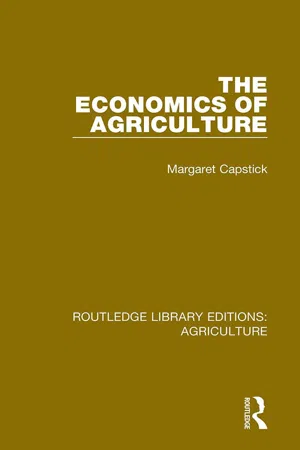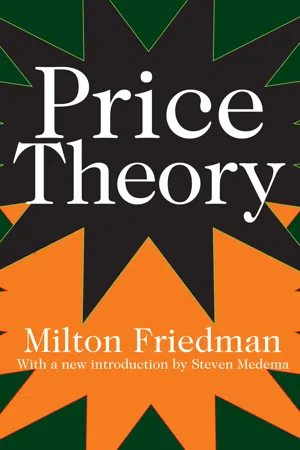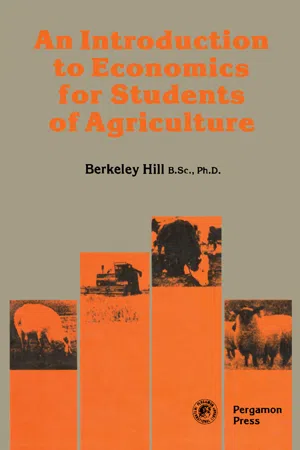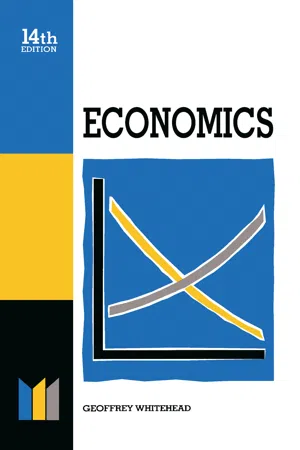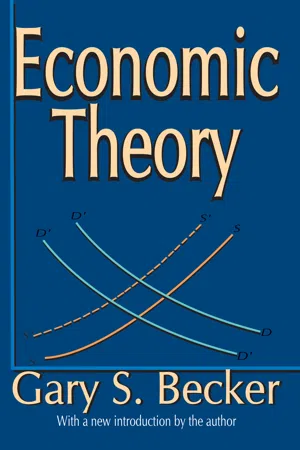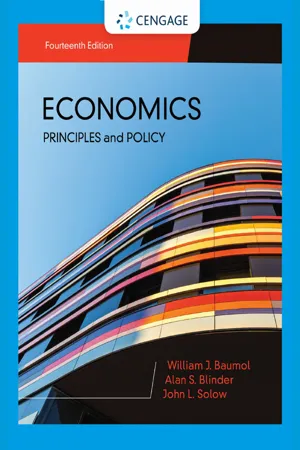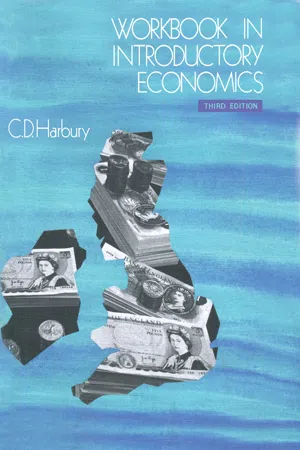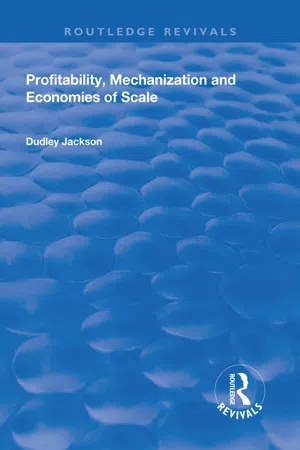Economics
Factors of Production
Factors of production are the resources used in the production of goods and services. They include land, labor, capital, and entrepreneurship. Land refers to natural resources, labor is the human effort involved in production, capital encompasses man-made tools and equipment, and entrepreneurship involves the organization and risk-taking necessary to bring the other factors together.
Written by Perlego with AI-assistance
Related key terms
1 of 5
12 Key excerpts on "Factors of Production"
- eBook - ePub
An Introduction to Economics
Concepts for Students of Agriculture and the Rural Sector
- Berkeley Hill(Author)
- 2021(Publication Date)
- CAB International(Publisher)
Chapter 8 ).Classification of Factors of ProductionAll production processes, whether of the self-sufficient sort or the product-exchange sort, involve taking a collection of inputs (for milk production these would include animal feed, water, labour for milking and stock care, land to grow fodder, buildings and equipment, and management skills) and combining them in some way, resulting in an output, or product. In our example we have several products – as well as milk, which is the primary product, calves and dung are by-products. It is generally agreed that the inputs to production processes can be classified into four broad groups of Factors of Production: (i) land; (ii) capital; (iii) labour; and (iv) entrepreneurship.Each main group of Factors of Production is considered separately in this chapter. Almost all production processes involve all four. Knocking a crab apple off a wild tree with a stick is a very simple process, but all four types of factor are present. The earth’s resources (land) have produced the apple, the stick is a piece of capital, labour was involved in using the stick, and the decision to pick the apple was an entrepreneurial one.Land as a Factor of ProductionLand as a factor of production has a particular importance for agriculture because, compared with other industries, farming requires a lot of it. According to OECD statistics in the UK, agriculture (excluding forestry) takes up about three-quarters of the total land area (rather more than the 51% for the EU as a whole) but it only engages about 1.0% of the UK working population (3.7% in the EU). Just as we describe a firm which needs a high proportion of labour in its mixture of inputs (such as thatching, or any craft work where mechanization is impossible) as labour-intensive, so we should label agriculture as land-intensive when comparing it to most other industries. - eBook - ePub
- Margaret Capstick(Author)
- 2019(Publication Date)
- Taylor & Francis(Publisher)
CHAPTER II The Factors of Production in AgricultureThe classical economists differentiated three Factors of Production: land, labour and capital. These are still convenient headings under which to discuss the inputs in agricultural production; their relative proportions change spatially and temporally, and the use made of any one of them is dependent on the available quantities of the others, as well as on the general conditions of demand for agricultural products.Problems of Factor Allocation
Suppose that a farm or a parcel of land is offered for sale. The neighbouring farmers, as well as possible buyers from a distance, will cast their eyes on it, and assess its possible value to them in the light of their command of the other two Factors of Production, labour and capital. Will they be able to work it with their existing machinery? If it was added to their present holding, would the existing farm buildings suffice to house the increased head of stock that the joint holding would carry? Or would a new set of buildings be needed, and how much would these cost? Would their financial assets extend to buying enough livestock to make full use of the extra land; or would it be better to put some of the newly acquired acres into arable, which needs less immediate capital outlay? Would the present labour force be able to cope with the extra work with existing plant; for example, would the present milking parlour be adequate for the milking of a bigger dairy herd with the present labour, or should there be two men to milk, or a parlour of a different design in which the present one cowman could milk the extra cows (in other words, could the productivity of present labour be increased)? Such questions show that one factor of production can rarely be considered in isolation; changes in one factor must be considered in the light of the availability of one or both of the other factors.This first set of questions concerns the balance of factors. At any one time, with given technology and given prices of inputs and of output, there will be one possible combination of factor inputs, either into an existing farm business or into a potentially expanded business which will be, for that business, the optimum combination or ‘bundle’; this combination will produce the greatest possible margin of revenue over costs. With optimal factor allocation, the marginal product of each factor will be equal. - eBook - ePub
- Milton Friedman(Author)
- 2017(Publication Date)
- Routledge(Publisher)
11The Supply of Factors of ProductionThe Factors of Production
Our discussion of demand for Factors of Production was in highly abstract terms; we did not consider the specific character of the Factors of Production or give them names. The reason is that on the demand side, there seems no empirical classification of factors that has such special importance as to deserve being singled out; the classification that is useful will vary from problem to problem. On the demand side, the chief consideration in classifying factors is substitution in production. A single factor consists of units that are regarded as perfect substitutes in production; different factors consist of units that are not perfect substitutes. For some problems, it will be desirable to separate out many different Factors of Production; for others, only a few.It has traditionally been supposed that conditions of supply give a more substantial and empirically significant basis for distinguishing among Factors of Production in specific terms. The classical economists distinguished three main Factors of Production: land, capital, and labor. Land they regarded as a permanent, nonreproducible resource fixed in amount, the supply of which was therefore perfectly inelastic to the economy as a whole. Capital they regarded as a reproducible resource, the amount of which could be altered through deliberate productive action, so its supply was not perfectly inelastic. Indeed, in the main, they tended to regard it as highly elastic. Labor, like capital, they regarded as reproducible and expansible, and, indeed, as supplied to the economy in the long-run at constant cost, yet to be distinguished from capital because of its dual status as a productive resource and an ultimate consumer. - Berkeley Hill(Author)
- 2013(Publication Date)
- Pergamon(Publisher)
As has been pointed out earlier, specialisation and exchange permits a higher level of production and consumption than could be achieved by self-sufficiency; the formal explanation for this will be presented when the bene-fits from international specialisation and trade are described (Chapter 8). 174 An introduction to Economics for Students of Agriculture CLASSIFICATION OF Factors of Production All production processes, whether of the self-sufficient sort or the product-exchange sort, involve taking a collection of inputs (for milk production these would include animal feed, water, labour for milking and stock care, land to grow fodder, buildings and equipment, manage-ment skills), and combining them in some way, resulting in an output, or product. In our example we have several products — as well as milk, which is the primary product, calves and dung are produced as by-products. It is generally agreed that the inputs to production processes can be classified into four broad groups of Factors of Production — land, capital, labour and entrepreneurship. Each main group of Factors of Production is considered below indivi-dually. Almost all production processes involve all four. Knocking a crab apple off a wild tree with a stick is a very simple process, but all four types of factor are present. The earth's resources (land) have produced the apple, the stick is a piece of capital, labour was involved in using the stick, and the decision to pick the apple was an entrepreneurial one. LAND AS A FACTOR OF PRODUCTION Land as a factor of production has a particular importance for agri-culture because, compared with other industries, farming requires a lot of it.- eBook - PDF
Economics
Made Simple
- Geoffrey Whitehead(Author)
- 2014(Publication Date)
- Made Simple(Publisher)
We therefore have a vicious circle, which spirals slowly upwards, but at an increasing pace as the years go by. (c) The incentives offered to labour. Where there are few incentives labour will be less efficient. Where the incentives are great labour will apply itself more assiduously. (d) The availability of other factors of high quality. This the commonest method of increasing the efficiency of labour. If it is backed by good quality land, labour itself will be more efficient. If it is backed by well chosen tools and adequate power supplies, even a poor labour force will be highly productive. One explanation of the great wealth of the US, despite the short working week and long holidays of its citizens, is that during his/her working hours every worker is supported by an array of power tools appropriate to his or her activities. 32 Economics 3.4 The Factors of Production—Capital The word 'capital' is used in many different ways today, but all its meanings refer to some stock of physical assets which have been created in the past and are available for present use. Thus social capital, such as schools, roads, and municipal swimming baths, has been created over the years by contributions in the form of rates and taxes. As a factor of production, capital means the stock of producer goods which are available to entre-preneurs for use in production. Producer goods are defined as goods which are not made to satisfy wants directly but are made to increase the eventual output of consumption goods by raising productivity in the fields, forests and factories of the earth. Thus a motor-driven saw raises the volume of timber cut by workers in the forestry and timber trades, resulting in an increased flow of timber products at cheaper prices into our homes. - eBook - ePub
- Gary Becker, Gary S Becker(Authors)
- 2017(Publication Date)
- Routledge(Publisher)
PART FOUR Supply of Factors of ProductionPassage contains an image
chapter 9 Human Capital
LECTURE 32
Land, Labor, and Capital
We have only casually discussed the determinants of the quantity supplied of different Factors of Production to an economy or to its various subdivisions. The supply of factors is one of the most difficult and unsettled topics in economic theory although progress has been rapid during the last 15 years. Consequently, our lectures on factor supply will be closer to the frontier of current research than were the lectures on the supply and demand of final products, production functions, and derived factor demand because these topics have been better worked out for a longer period.The classical economists presumed three basic Factors of Production: land, labor, and capital (called the “holy trilogy of economics” by Frank Knight) according to their presumed supply responses to prices. Land was assumed to be endowed by “nature” with “original and indestructible properties” (to use David Ricardo’s term) that were unresponsive to changes in the price of land. The supply of labor, on the other hand, was assumed to be regulated by the forces of misery, vice, and virtue. If wage rates rose above the “ subsistence” level, the supply of labor would readily increase both because births would be increased by earlier marriages and less abstinence while married and because deaths from disease and starvation would decrease. The elasticity of labor was, therefore, presumed to be high. The elasticity of the supply of physical capital was considered to be between those of labor and land although closer to the former.These distinctions were not valid even in the nineteenth century, and today they are extremely misleading. Although the physical size of the earth has been fixed and indestructible (trips to outer space have begun to change this!), the economic supply of land has been greatly changed by man’s efforts. For example, much of the land in the Netherlands was under water a few hundred years ago and became available only through large-scale drainage programs. Similarly, irrigation programs have greatly increased the agricultural land in Israel and other dry parts of the world. Mankind has also cleared forests, drilled oil wells on the bottoms of seas, built tall buildings, and so forth. Economists now recognize these developments by treating land simply as a “produced” durable factor of production, that is, as one kind of capital. - eBook - ePub
Economic Lessons from the Transition: The Basic Theory Re-examined
The Basic Theory Re-examined
- Daniel R. Kazmer, Michele Konrad(Authors)
- 2016(Publication Date)
- Routledge(Publisher)
3 The Factors of ProductionHow Incomes Are Determined
Factors are the inputs into the production process. Traditionally, theory deals with three general categories. Land—including timber, fisheries, and other natural resources—earns rents. Labor earns wages. Capital—meaning here plant and equipment, not money—earns profits. These factors combine to make every product and service sold on the market.But how much are these factors worth, and who or what determines the income paid to the factor owners? Historically, this question has been answered both by political theory (capitalism, Marxism-Leninism, socialism) and by economic theory. We will first discuss economic theory, although the political theory relating to factor incomes is also interesting and important.Economic theory has developed an elegant and optimal determination of factor incomes, the theory of perfect competition. It applies the same marginal optimizing rules to factor markets that it applies to product markets.As in product markets, each factor will be paid the contribution of its marginal product to marginal revenue. Thus, if the last worker hired adds one-tenth of a widget per hour to total output and that last widget sold adds 10 euro to total revenue, then all workers will be paid the value of their marginal revenue product or 10 euro X 1/10 widgets = 1 euro/hour.Economic theory then proves that a competitive economy will make optimal use of its factors, from inputs to production, since each factor will move to the productive activity at which it is paid the most, that is, where the value of its marginal revenue product is highest. They will stop moving and be at equilibrium when the values of all their marginal revenue products are equal—when output can no longer be increased by moving inputs around. - eBook - PDF
Economics
Principles & Policy
- William Baumol, Alan Blinder, John Solow, , William Baumol, Alan Blinder, John Solow(Authors)
- 2019(Publication Date)
- Cengage Learning EMEA(Publisher)
The American Factors of Production are the broad categories— land, labor, capital, natural resources, and entrepreneurship—into which we classify the economy’s different productive inputs. The outputs of a firm or an economy are the goods and services it produces. “And may we continue to be worthy of consuming a disproportion- ate share of this planet’s resources.” Lee Lorenz The New Yorker Collection/The Cartoon Bank. 2017 Gross Domestic Product (GDP) per Capita in 7 Industrial Countries 59,500 50,200 48,100 43,600 43,600 42,700 38,000 0 10,000 20,000 30,000 40,000 50,000 60,000 70,000 United States Germany Canada United Kingdom France Japan Italy U.S. Share of World GDP—It’s Nice to Be Rich The roughly 7.5 billion people of the world produced approximately $76 trillion worth of goods and services in 2016. The United States, with only about 4.5 percent of that population, turned out almost 25 percent of all the output. As the accompanying graph shows, among the seven largest developed countries of the world, the United States is still the leader in goods and services, with $59,500 worth of GDP produced per person. These seven major industrial economies (the United States, Canada, Germany, the United Kingdom, Japan, France, and Italy), which account for just over 10 percent of global population, generated more than 45 percent of world output in 2017. But their share has been falling as giant developing nations like China and India grow rapidly. SOURCE: Central Intelligence Agency, The World Factbook, https://www.cia .gov/library/publications/the-world-factbook/rankorder/rawdata_2004.txt Note: Foreign GDPs are converted to U.S. dollars using exchange rates. Copyright 2020 Cengage Learning. All Rights Reserved. May not be copied, scanned, or duplicated, in whole or in part. Due to electronic rights, some third party content may be suppressed from the eBook and/or eChapter(s). - eBook - PDF
- Colin Harbury(Author)
- 2014(Publication Date)
- Pergamon(Publisher)
CHAPTER 4 Distribution: Factors of Production and their Prices The study of Factors of Production plays a double role in economics. It helps to answer two of the main questions referred to at the beginning of this book: (1) how production is best organized (because factor prices and productivities lie behind the cost curves of firms) and (2) for whom goods are produced (because the prices of Factors of Production lie behind the distribution of incomes). Market determination of the prices of Factors of Production, labour, capital and land, is analysed in a manner closely paralleling that used for the prices of goods and services — by studying the forces of supply and demand. DEMAND The demand for the services of a factor of production is the schedule of quantities which businesses want to buy at varying prices during a period of time. The demand is said to be DERIVED from the value of the goods which a factor produces. It is determined by a factor's productivity and the ease with which it may be substituted for other factors. The elasticity of demand for a factor depends on these influences, on the time allowed for a price change to take effect and on the relative importance of the factor in total costs. The technical efficiency, or productivity, with which Factors of Production can be combined to produce given outputs (the PRODUCTION FUNCTION) is a basic determinant of the costs of a firm. When the prices of the services of factors are known, a firm is able to select the least cost combination for each level of output. Productivity depends critically upon whether the short period or the long period is under consideration. The short period is defined as that during which at least one of the factors is fixed in supply. As units of a VARIABLE factor are used together with a fixed one, the MARGINAL PHYSICAL PRODUCT (M.P.P.) of the variable factor tends eventually to fall. This phenomenon is known as the LAW OF DIMINISHING RETURNS. - Dudley Jackson(Author)
- 2018(Publication Date)
- Routledge(Publisher)
Economic resources may also be called the ‘Factors of Production’. The meaning of the word ‘capital’ as it is used in economics is a produced means o f production. The word ‘capital’ as used throughout this book refers only to tangible assets or real things. Financial assets—claims on others— should not in economics be called ‘capital’ despite a common tendency in accountancy and elsewhere to include financial assets under ‘capital’. The word ‘wealth’ may be used to refer to the total value of capital owned and financial assets owned. More technically, the term ‘net worth’ may be used to refer to: the value of capital owned plus the value of financial assets owned minus the value of financial liabilities owed. There are two types of capital: fixed capital and circulating capital. Fixed capital may also be referred to as ‘fixed assets’; circulating capital is more commonly referred to as ‘inventories’. The defining characteristic of fixed capital is that any item in the stock of fixed capital has a repeated use in the process of production; that is, an item of fixed capital can be used to produce one piece of output and it then remains available to produce another piece of output and so on. The defining characteristic of circulating capital is that any item in the stock of circulating capital has a once-for-all use in the process of production; that is, once an item of circulating capital has been used to produce one piece of output it is then completely ‘used up’ and is not available to produce another piece of output. The Resource Costs of Production 9 To illustrate: the sewing machine of a dress-maker is an item of fixed capital; the dress fabric used by a dress-maker is an item of circulating capital. But both sewing machine and dress fabric are capital: a produced means of production.- eBook - PDF
Economic Environment NQF2 SB
TVET FIRST
- B Serfontein(Author)
- 2013(Publication Date)
- Macmillan(Publisher)
● They take on the responsibility and risk of combining and organising resources to produce goods and services for which there is a demand and from which they can make a profit. ● Entrepreneurs are responsible for introducing new products and new ways of producing goods and services, opening new markets and establishing new organisations in an industry. ● They are innovators because they transform creative ideas into goods and services for society. Assessment activity 4.1 1. List the different Factors of Production that are required for production to take place. 2. Define the four Factors of Production and give an example of each. 3. Complete the table below. The first column lists some of the things that are needed to produce a wooden table. Say what kind of factor of production it represents. The Factors of Production Wood Saw Carpenter Hammer The person who decides to produce the wooden tables 4. Distinguish between natural resources and capital by referring to the characteristics of each. 5. List the characteristics of labour that makes it different from the other Factors of Production. 6. What do you think can be done to increase the number of entrepreneurs in the South African economy? Keep this assessment activity in your Portfolio of Evidence. 37 Unit 4: The production of goods and services 4.4 Creating economic value through production During the production process, value is created. The different kinds of value created are form value, time value, place value and possession value. Factors of Production Natural resources Labour Capital Entrepreneurship Production Combining the Factors of Production Output Goods and services Exchange Exchange of goods and services Consumption Satisfaction of needs and wants 4.3 The production process The production process involves combining the Factors of Production and transforming them to produce goods and services. These goods and services are then exchanged on the market and consumed to satisfy needs and wants. - eBook - PDF
Energy and Economic Myths
Institutional and Analytical Economic Essays
- Nicholas Georgescu-Roegen(Author)
- 2014(Publication Date)
- Pergamon(Publisher)
The first concerns the long-standing denial of the value of Ricardian land and natural resources. But there can be no doubt that Ricardian land must be included in a complete description of a productive process. In agriculture, in particu-lar, Ricardian land plays a role wholly analo-gous to that of a fisherman's net; only, instead of fish, it catches solar energy and its by-prod-ucts [6, p. 508]. As to the natural resources, we may recall that Karl Marx, of all the econo-mists, recognized that no one can fish from a ls The complications inherent to joint products must be left out at this stage. lake where there are no fish. The omission of these two factors in standard analytical eco-nomics as well as in most applied works may also be imputed to the neglect of standard economists for any epistemological clarification of the production function. The consequence has been that the economic process is now viewed as a simple circular affair, as a mechani-cal analogue, which, like a pendulum, just beats time, but makes no history. The actual economic process, on the contrary, is making its own history, through the continuous tapping of natural resources and the search for a more efficient use of these scarce economic factors. The second point is that in absolutely any elementary process numerous factors are in-evitably idle during parts of the duration. This technical idleness is the worst form of economic waste and a great hamper to economic progress. Unfortunately, natural as well as economic factors prevent its complete elimination. The natural factors pertain to season. Some ac-tivities, especially farming, have a temporal rhythm over which, for all practical purposes, man has hardly any control. One can begin at any time of the day, of the week, or of the year, an elementary process by which a table or an automobile is produced. But a corn grower must sow corn in the fields within a specific, very short period of the year if he wants to have a crop.
Index pages curate the most relevant extracts from our library of academic textbooks. They’ve been created using an in-house natural language model (NLM), each adding context and meaning to key research topics.
